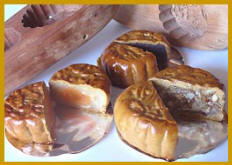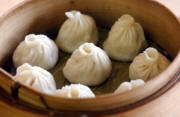Houston Asian Restaurant Guide > Chinese Food Articles > Popular Food Culture in Taiwan
Food culture represents one face by which a country knows
itself and by which it shows itself to the world. Due to its great ethnic
diversity, Taiwan has a wide variety of such faces and, moreover, these have
increased and strengthened with the rise in local awareness. This diversity of
cuisines includes eight main categories:
In general, therefore, it can be said that Taiwan's varied cuisine shows ethnic, geographic, economic, and other cultural influences.
This situation can be illustrated using the example of Changhua County in west-central Taiwan. While Changhua's one city and 25 townships have a variety of distinctive geographic conditions, there is an overall tendency towards agriculture, meaning that Changhua foodstuffs tend to have a rural flavor. Local influence can be seen on top of this, however, such as in the seafood ingredients used for coastal dishes such as o-a-zen (oyster omelet) and o-a-mi-sua (slender noodles with oysters), which are considered Changhua specialties.


Agricultural communities throughout Taiwan tend not to include beef as a staple of their diet, so Changhua's meat dishes are also generally based on pork. These include rice with stewed pork, and ba-wan (rou-yuan in Mandarin), which are meatballs in a large dumpling. These are so famous that throughout Taiwan, they are known as Changhua rou-yuan. These meatballs are made using bamboo shoots and mushrooms as well as pork, and the dough is generally made using sweet potato starch.
This shows how such dishes are closely bound to the agricultural societies that produced them. Local religious activities have also contributed to the development of pastry making, so that Changhua's many old pastry shops now enjoy widespread reputation.
Rural Roots
The situation in Taoyuan can be contrasted to that in Changhua.
The culinary culture of the 13 conurbations of this northern country was
originally similar to that of Changhua discussed above. Following settlement by
large numbers of mainland veterans and the arrival of foreign workers, however,
local cuisine has been influenced markedly. Initial Han-Chinese inhabitations of
Taoyuan had been mostly descendants of immigrants from Zhangzhou area of China's
Fujian Province. The rich tapestry of local inhabitations also includes
indigenous Atayal, Hakka, and immigrants from Matsu Island and Yunnan Province,
giving rise to an equally rich variety of cuisines.
 Following
the arrival of foreign laborers, Southeast Asian restaurants have also
prospered, while the Hot and Spicy Beef Noodles of the veterans' community has
become another feature of local food over the last few decades.
Following
the arrival of foreign laborers, Southeast Asian restaurants have also
prospered, while the Hot and Spicy Beef Noodles of the veterans' community has
become another feature of local food over the last few decades.
Local Food Dishes
In contrast to the refined dishes served at elegant banquets are a wide variety of local foods generally known as siao-chih ("small eats") in Mandarin, which are something like a delicacy, snack, or one dish of a main meal. These are local dishes with the taste of the countryside. They are the product of folk culture and represent popular aesthetics. Superficially, therefore, siao-chih, seem to be quite the opposite of banquet dishes: folk as opposed to elegance, of different classes, with different flavors. For some time, however, siao-chih culture has been on the rise, honing its qualities, and attracting attention and praise from all strata of society. This goes to show that there are no distinct boundaries between the two culinary cultures but, rather, that they share much in common.
Shao-chih are "folk" in that their contents relate to people's lives; they originated in everyday life, and are permeated with popular features. Taiwan's siao-chih have flavors from throughout China as well as from Taiwan, Penghu, Kinmen, and Matsu. Folk siao-chih are found throughout Taiwan's culinary world, in all the eight main categories of cuisine, and might be generally termed "Taiwan's folk siao-chih." This comprises both foodstuffs and local produce, which differ in both characteristics and culinary methods. Each area has its geographic characteristics, resulting in a myriad of folk siao-chih.
Melting Pot
Another category is Taiwanese cuisine which, as the name implies, means genuine Taiwan dishes. These represent the culinary culture accumulated by descendants of Taiwan's pioneer immigrants over the past four centuries, and which, therefore, most typify the flavor of the land and its people. In fact, Taiwanese cuisine can be divided into Holo (Minnanese), Hakka, and aboriginal dishes.
Hunting and fishing played an important role in the lives of Taiwan's indigenous peoples and so meats and fish figure prominently in their festive cuisine. Some aboriginal groups fermented millet wine, which is also now celebrated as a characteristic cultural trait.
Most if Taiwan's early Han-Chinese settlers came from Fujian and Guangzhou provinces, in particular from the Zhangzhou and Quanzhou regions of Fujian, an area of the southeast coast of China known for seafood cuisine. Under geographic, climatic, agricultural, fishing, and economic influences, after settlement on Taiwan they and their descendants gradually developed a culinary culture that was simple, light, and centered on seafood. Over the centuries, this Taiwan cuisine took on a new identity with local characteristics.
Advertisement
Hakka people were also among the pioneers who crossed the seas to Taiwan. They toiled hard to cultivate new land, built their homes, and lived thrift and simple lives. This is also manifested in their cuisine, which tends to be salty, fragrant, and oily. Hakka foods are best known for these flavors, with famous salty dishes including steamed and chopped chicken, steamed streaky pork with dry mustard cabbage, Hakka stir-fry (with pork, dried squid, and dried bean curd), and "luck vegetable soup" made with dried mustard greens. A combination like this makes a memorable meal.
All these eight major categories of cuisine represent Taiwan's
haute cuisine. The foods most people consume on a daily basis, what might be
called Taiwanese siao-chih, can also be divided into eight main categories
according to their primary ingredients:
• Poultry: boiled salted duck, roast duck, a-hsiew Yilan-style marinated and smoked duck, chicken stewed in Chinese herbs, "drunken" chicken (steamed in wine), rice with shredded chicken meat, steamed chicken, etc.
• Meat: Beef noodles, cow viscera soup, mutton rice noodles, mutton stewed with Chinese angelica, dried meat, crispy meat, preserved or processed meat, meatballs, ba-wan (meatballs in a dumpling), etc.
• Fish and seafood: milkfish porridge, steamed grouper, fried white hairtail, o-a-zen (oyster omelet), mangrove, crab porridge, etc.
• Rice and noodle dishes: Hsinchu rice noodles, Nantou slender noodles, Taiwanese rice noodles, "slab" noodles, glutinous rice tamales with meat and other fillings, wa-guei "bowl-pasties" (stuffed flour dumplings), and o-a-mi-sua (slender noodles with oysters), etc.
• Bean curd and vegetarian fare: Shenkeng tofu, Dasi dried bean curd, "stinky" tofu, and various kinds of vegetarian dishes.
• Sweet and savory pastries: sweet stuffed dumplings wuch as mua-ji, aboriginal millet cake, and Hakka glutionous rice cake; egg-yolk shortbread, pineapple cake, crispy wedding meat pie, crispy cookie, sun-shaped pastry, ox-tongue-shaped pastry, salty pie, Yokan, white gourd cake, cake made from glutinous rice powder, maltose puff rice balls, etc.
• Beverages: honey bean ice, papaya milk shake, taro ice, honey, carambola juice, grass jelly, sugarcane juice, bitter tea, Hakka leicha (pounded tea), jelly fig ice, "pearl milk tea", etc.
• Sauces and seasonings: spicy soybean sauce, fermented bean curd paste, pickled vegetables, pickled mustard tuber, sesame oil sauce, soy sauce, oyster sauce, soybean sauce, etc.
With the emergence of a stable foundation of economic prosperity over the last half-century, Taiwan's people became more particular about their eating culture, giving it new life and enriching its content. The eight major categories of dishes covered include a comprehensive range of both everyday and more refined foods. These siao-chih are intimately bound to popular customs. Becoming familiar with Taiwan's foods enables the diner to better understand the country and its peoples, and the place that foods occupy in their hearts.
Read more about Taiwan Culture
